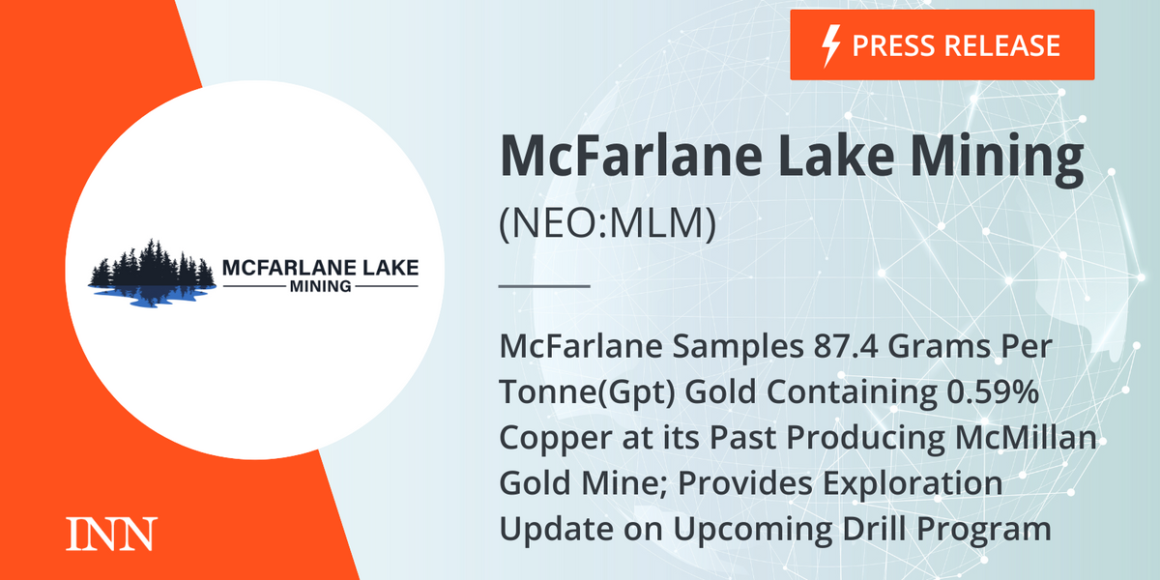Highlights
The McMillan Gold Mine was a past producer of gold and is located within 3 km from major highways and power lines. Located geologically in the Huronian Gold Belt 70 km west of Sudbury (Figure 1), this area of the province has been consistently identified as a top gold and polymetallic exploration opportunity as highlighted in the Ontario Geological Survey’s “Recommendation for Exploration 2010 to 2011” and “Recommendation for Exploration 2017 to 2018”.
Drilling Program
The company has applied for an exploration permit to conduct an initial 3,000 metre drill program, with plans to commence drilling in Q4 2024. The program is fully funded and designed to test and expand on historic high-grade gold intercepts at the McMillan Gold Mine (Figure 2) and to better understand the geology of the deposit.
A recent sample taken at the site, from what is interpreted to have been historic ore from the McMillan Gold Mine, returned 87.4 gpt gold, 0.59% copper and anomalous cobalt and nickel (Figure 3). This has demonstrated the potential for high-grade gold within the setting of a polymetallic mineralized system. Thus far, McFarlane has not seen any historic assays for copper and other base metals in historic data from the mine. This presents an opportunity to add significant value to the property. The company is also testing for platinum and palladium values, these have yet to be received.
The property has not been drilled since the early 2000’s where exploration intersected 27.9 metres of 6.4 gpt gold including 8.1 metres of 15.7 gpt below the historic mine. In addition to testing historic intercepts, the company also plans to test the system along strike and at depth to materially expand the mineralization for a future resource estimate. Historic drill core is not available for analysis, hence upcoming diamond drilling will help understand the sub surface geology and allow for polymetallic analysis of drill core samples (ie gold, copper, cobalt and nickel).
Advancing Regional Surface Targets
The company has recently completed its regional geological data compilation on the property which was performed by ORIX Geoscience. This information is being used to assess exploration targets on the property. Multiple high-priority targets have been outlined across the underexplored 32 sq. km property (Figure 4). Evaluation of the targets has been based on positive magnetic anomalies and historic surface sampling. Historic ore at the McMillan Gold Mine contains pyrrhotite and is magnetic. Magnetic anomalies identified from historic geophysical surveys may be expressions of additional areas of mineralization and will be explored. Surface sampling -conducted in 2022 by McFarlane- associated with some of the magnetic anomalies returned assays up to 10.9 gpt gold and 0.12% copper, as well as anomalous cobalt and nickel up to 487 and 468 ppm respectively. The identification of polymetallic mineralization suggests strong potential exists across the property that was not historically tested. Prior to the upcoming drill program, the company plans to evaluate these regional targets for polymetallic gold mineralization in hopes to discover additional prospects for drilling.
Qualified Person
The scientific and technical information disclosed in this news release was reviewed and approved by Wesley Whymark, P. Geo., Consulting Geologist for the company, and a Qualified Person as defined under National Instrument 43-101.
Technical Information
The samples collected by McFarlane Lake Mining and described in this news release were transported in secure sealed bags for preparation and assay by Agat Labs. The samples reported were crushed in their entirety to 80% passing -10 mesh, with one 500 g subsample split and pulverized to 95% passing 150 mesh. One 50 g aliquot was taken from the subsample for fire assay (FA) with an AAS finish. Samples over 10 g/t gold were subject to a 50 g aliquot FA with gravimetric finish. Multi-element assays were done by ICP-OES finish.
Compliant Resources
About McFarlane Lake Mining Limited
McFarlane is a gold exploration company focused on the exploration and development of its portfolio of properties. The past producing McMillan and Mongowin gold properties, located 70 km west of Sudbury, Ontario, the past producing West Hawk Lake property located immediately west of the Ontario-Manitoba border, and the High Lake gold property (see Table 1 for resource statement) located immediately east of the Ontario-Manitoba border and 8 km from the West Hawk lake property. McFarlane also owns the Michaud/Munro mineral property situated 115 km east of Timmins along the so-called “Golden Highway”. McFarlane is a “reporting issuer” under applicable securities legislation in the provinces of, British Columbia, Alberta and Ontario.
Cautionary Note Regarding Forward-Looking Information
This news release contains “forward-looking information” and “forward-looking statements” (collectively, “forward-looking statements”) within the meaning of the applicable Canadian securities legislation. All statements, other than statements of historical fact, are forward-looking statements and are based on expectations, estimates and projections as at the date of this news release, including without limitation; anticipated results of geophysical surveys or drilling programs, estimated timing, geological interpretations and potential mineral recovery processes. Any statement that involves discussions with respect to predictions, expectations, beliefs, plans, projections, objectives, assumptions, future events or performance (often but not always using phrases such as “expects”, or “does not expect”, “is expected”, “anticipates” or “does not anticipate”, “plans”, “budget”, “scheduled”, “forecasts”, “estimates”, “believes” or “intends” or variations of such words and phrases or stating that certain actions, events or results “may” or “could”, “would”, “might” or “will” be taken to occur or be achieved) are not statements of historical fact and may be forward-looking statements.
For Further Information, Please Contact:


Leave a Reply